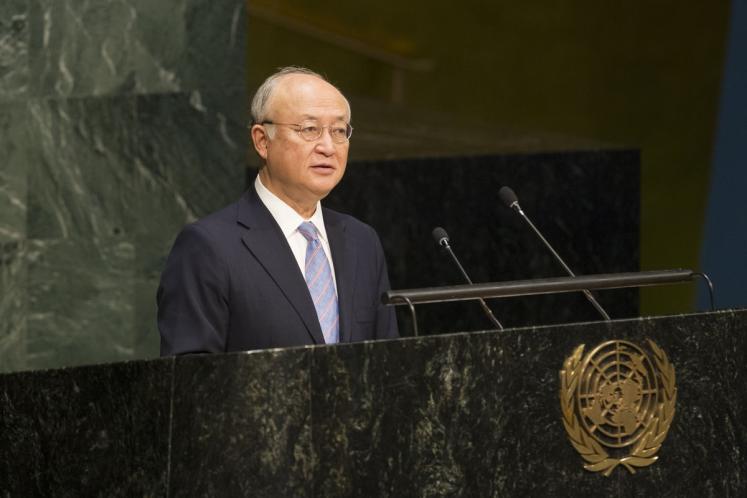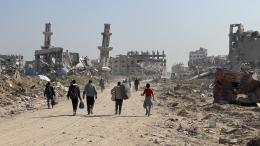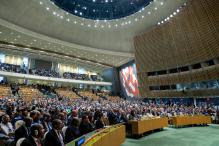It became official with the closing meeting of the month-long Ninth Review Conference of the Nuclear Non-Proliferation Treaty (NPT): the parties could not reach consensus agreement on a substantive final declaration. Throughout the week, Ambassador Taous Feroukhi of Algeria – President-designate of the conference – had implored delegates to make a last ditch effort to reach such an agreement. She departed from procedure, first by extending the schedule of work among the three Main Committees into the final week with a host of informal plenaries, and again by circulating the final draft of the document well past midnight on the penultimate day of the conference, minimizing the time delegates had to consult with their home governments. The concluding plenary itself was delayed and then temporarily suspended as negotiations continued beyond the eleventh hour. Yet, the flurry of activity ultimately failed to pay off.
By all accounts, the failure of the 2015 conference to produce a consensus outcome document with any substance can be attributed to the discussions around the establishment of a WMD-free zone in the Middle East, an issue linked to a resolution adopted at the 1995 NPT Review and Extension Conference. According to the head of the United Kingdom’s delegation, “this issue and this issue alone was the stumbling block.” The final document of the 2015 conference would have imposed a March 2016 deadline for convening a conference towards this end, part of a last-minute plan drafted by the Russians (cosponsors of the 1995 resolution along with the United States and the U.K.). But the U.S. decried the “arbitrary deadline,” while Canada demanded that any negotiations on this issue include Israel, a non-NPT party. At the contentious final plenary, the U.S. criticized the inflexibility of the Arab League on the subject, singling out Egypt. For its part, Egypt – as well as Russia and the Non-Aligned Movement – blamed the obstructionism of the Americans, British, and Canadians.
The controversy over the Middle East all but effectively marks the end of the renewed effort undertaken at the previous Review Conference to implement the 1995 resolution. The 2010 final document had prescribed the convening of a conference on the zone before the end of 2012 – which never happened – and oversaw the designation of a host country (Finland) and facilitator (Jaakko Laajava). The lack of forward movement on this issue has been a particular sore spot for non-nuclear weapon state parties to the treaty. Its role in this conference’s breakdown could portend further trouble for the non-proliferation regime; after all, scholars acknowledge that the treaty’s indefinite extension in 1995 would have been a much more arduous process without the Middle East resolution. As the 2015 conference fell apart, Egypt, a long-time proponent for the zone, bitterly pointed to the “fallacious nature of the 1995 process.”
At the same time, this emphasis on the clash over the Middle East zone belies the myriad disagreements that arose during the month-long conference. As previously argued, a substantive final declaration would not have cured all that ails the non-proliferation regime. This appears manifestly true in light of the meager final draft outcome document ultimately rejected by the treaty parties. Even those parties that expressed the willingness to support its adoption did so “despite its shortcomings” (Brazil), noting that the document “falls short of… expectations” (Indonesia) and indicating “some reservations” (Russia) with several provisions. The Association of Southeast Asian Nations (ASEAN) also revealed that some small delegations “felt excluded” from the negotiating process. The overall text essentially reiterated the conclusions and recommendations of the 2010 outcome document, offering only minimal advancement of its 64-point action plan, and devoting little space to a review of its implementation: hardly a formula for progress.
Two days before the 2015 conference concluded, Ambassador Feroukhi identified substantial gaps that remained in three areas: effective measures towards nuclear disarmament, humanitarian aspects of nuclear weapons use, and reporting by the recognized nuclear-weapon states. Notably, the rejected draft outcome document generally sidestepped each of these issues. One exception was a modest directive that would have required the nuclear-weapon states to submit reports on disarmament action at the 2017 and 2019 Preparatory Committees. The divide between the nuclear weapon states – the permanent five members of the UN Security Council – and the other parties to the treaty thus remains readily apparent. South Africa even invoked apartheid in describing the system in place.
It is difficult to assess what the failed Review Conference means for the future of the NPT. In some senses, it is business as usual, as parties to the 45-year old treaty have never been able to reach consensus on substantive outcomes in two consecutive conferences. Despite their objections to the plan presented, the U.S., U.K., and Canada expressly noted they would not be averse to a Middle East WMD-free zone process, depending on the details. Meanwhile, a Joint Comprehensive Plan of Action reached by the permanent members of the UN Security Council plus Germany (P5+1) and Iran before the June 30th deadline could help reinvigorate the regime, as it would bolster the IAEA safeguards system undergirding the treaty, and allow the international community to focus on North Korea, the other outstanding non-compliance case (the country withdrew from the treaty in 2003).
Still, the 2015 Review Conference feels like an opportunity squandered. The discord that surrounds nuclear disarmament will not dissipate, as evidenced by the 107 countries now signed onto an Austrian-led Humanitarian Pledge pushing for “effective measures to fill the legal gap for the prohibition and elimination of nuclear weapons.” Moreover, the continued fragmentation of the NPT membership has negative implications for its other goals: the further entry into force of comprehensive safeguard agreements and additional protocols, ratification of the amendment to the Convention on the Physical Protection of Nuclear Materials, and negotiation of the Fissile Material Cut-Off Treaty. The NPT remains the cornerstone of the non-proliferation regime. But because of that, its failed Review Conference too will have reverberations across the nuclear landscape.
Suggested citation: Wilfred Wan., "Why the 2015 NPT Review Conference Fell Apart," UNU-CPR (blog), 2015-05-28, https://unu.edu/cpr/blog-post/why-2015-npt-review-conference-fell-apart.




